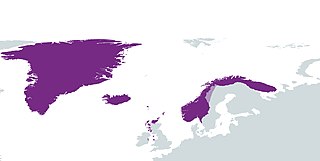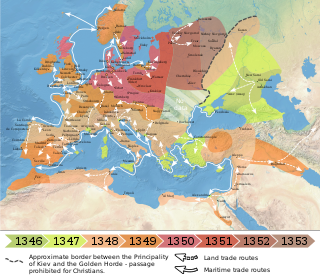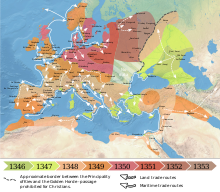
The Kalmar Union was a personal union in Scandinavia, agreed at Kalmar in Sweden as designed by widowed Queen Margaret of Norway and Sweden. From 1397 to 1523, it joined under a single monarch the three kingdoms of Denmark, Sweden, and Norway, together with Norway's overseas colonies.

The Scandinavian Peninsula is located in Northern Europe, and roughly comprises the mainlands of Sweden, Norway and the northwestern area of Finland.

The history of Greenland is a history of life under extreme Arctic conditions: currently, an ice sheet covers about eighty percent of the island, restricting human activity largely to the coasts. The first humans are thought to have arrived in Greenland around 2500 BCE. Their descendants apparently died out and were succeeded by several other groups migrating from continental North America. There has been no evidence discovered that Greenland was known to Norsemen until the ninth century CE, when Norse Icelandic explorers settled on its southwestern coast. The ancestors of the Greenlandic Inuit who live there today appear to have migrated there later, around the year 1200, from northwestern Greenland.

The history of Norway has been influenced to an extraordinary degree by the terrain and the climate of the region. About 10,000 BC, following the retreat inland of the great ice sheets, the earliest inhabitants migrated north into the territory which is now Norway. They traveled steadily northwards along the coastal areas, warmed by the Gulf Stream. They were hunter-gatherers whose diet included seafood and game, particularly reindeer as staple foods. Between 5,000 BC and 4,000 BC the earliest agricultural settlements appeared around the Oslofjord. Gradually, between 1,500 BC and 500 BC, agricultural settlements spread to the entire south Norway, while the inhabitants of the regions north of Trøndelag continued to hunt and fish.

Haakon IV Haakonsson, sometimes called Haakon the Old in contrast to his namesake son, was King of Norway from 1217 to 1263. His reign lasted for 46 years, longer than any Norwegian king since Harald Fairhair. Haakon was born into the troubled civil war era in Norway, but his reign eventually managed to put an end to the internal conflicts. At the start of his reign, during his minority, Earl Skule Bårdsson served as regent. As a king of the Birkebeiner faction, Haakon defeated the uprising of the final Bagler royal pretender, Sigurd Ribbung, in 1227. He put a definitive end to the civil war era when he had Skule Bårdsson killed in 1240, a year after he had himself proclaimed king in opposition to Haakon. Haakon thereafter formally appointed his own son as his co-regent.

Eric of Pomerania, ruled over the Kalmar Union from 1396 until 1439. He was initially co-ruler with his great-aunt Margaret I until her death in 1412. Eric is known as Eric III as King of Norway (1389–1442), Eric VII as King of Denmark (1396–1439) and has been called Eric XIII as King of Sweden. Eric was ultimately deposed from all three kingdoms of the union, but in 1449 he inherited one of the partitions of the Duchy of Pomerania and ruled it as duke until his death in 1459. His epithet of Pomerania was a pejorative intended to insinuate that he did not belong in Scandinavia.

Magnus IV was King of Sweden from 1319 to 1364, King of Norway as Magnus VII from 1319 to 1355, and ruler of Scania from 1332 to 1360. By adversaries he has been called Magnus Smek.
This is a timeline of Faroese history comprising important legal and territorial changes and political events in Iceland and its predecessor states. To read about the background to these events, see history of the Faroe Islands.
Riksrådet or Rigsrådet is the name of the councils of the Scandinavian countries that ruled the countries together with the kings from late Middle Ages to the 17th century. Norway had a Council of the Realm that was de facto abolished by the Danish-Norwegian king in 1536–1537. In Sweden the parallel Council gradually came under the influence of the king during the 17th century.
Paul Knutson was a 14th-century law officer in Bergen, Norway.

The Black Death was one of the most devastating pandemics in human history, resulting in the deaths of an estimated 75 to 200 million people in Eurasia, and peaking in Eurasia from 1321 to 1353. Its migration followed the sea and land trading routes of the medieval world. This migration has been studied for centuries as an example of how the spread of contagious diseases is impacted by human society and economics.

Denmark and Norway have a very long history together: they were both part of the Kalmar Union between 1397 and 1523, and Norway was in a Union with Denmark between 1524 and 1814.

Denmark–Norway was a 16th-to-19th-century multi-national and multi-lingual real union consisting of the Kingdom of Denmark, the Kingdom of Norway, the Duchy of Schleswig, and the Duchy of Holstein. The state also claimed sovereignty over three historical peoples: Frisians, Gutes and Wends. Denmark–Norway had several colonies, namely the Danish Gold Coast, the Nicobar Islands, Serampore, Tharangambadi, and the Danish West Indies. The union was also known as the Dano-Norwegian Realm, Twin Realms (Tvillingerigerne) or the Oldenburg Monarchy (Oldenburg-monarkiet).
The military history of Norway commences before the Viking Age with the internal wars fought between regional kings to obtain the supreme kingship of the whole of Norway. The most famous period of Norwegian history and thus military history is the Viking Age, but the early Middle Ages was the era when Norwegian military power in Europe reached its peak. Since then the Norwegian military has experienced long periods of neglect, but also rearmament and victories.

The term Norwegian Realm and Old Kingdom of Norway refer to the Kingdom of Norway's peak of power at the 13th century after a long period of civil war before 1240. The kingdom was a loosely unified nation including the territory of modern-day Norway, modern-day Swedish territory of Jämtland, Herjedalen, Ranrike (Bohuslän) and Idre and Särna, as well as Norway's overseas possessions which had been settled by Norwegian seafarers for centuries before being annexed or incorporated into the kingdom as 'tax territories'. To the North, Norway also bordered extensive tax territories on the mainland. Norway, whose expansionism starts from the very foundation of the Kingdom in 872, reached the peak of its power in the years between 1240 and 1319.

The Black Death was present in France between 1347-1352. The bubonic plague pandemic, known as the Black Death, reached France by ship from Italy to Marseille in November 1347, spread first through Southern France, and then continued outwards to Northern France.

The Black Death was present in the Holy Roman Empire between 1348 and 1351. The Holy Roman Empire, composed of today's Germany, Switzerland, Austria, Belgium and the Netherlands, was, geographically, the largest country in Europe at the time, and the pandemic lasted several years due to the size of the Empire.

The Black Death was present in Sweden between 1350 and 1351. It was a major catastrophe which was said to have killed a third of the population, and Sweden was not to recover fully for three hundred years.

The Black Death was present in Denmark between 1348 and 1350. The Black Death in Denmark is the least documented of all the Nordic countries, with the exception of Finland.

The Black Death was present in the Middle East between 1347 and 1349. The Black Death in the Middle East is described more closely in the Mamluk Sultanate, and to a lesser degree in Marinid Sultanate of Morocco, the Sultanate of Tunis, and the Emirate of Granada, while information of it in Iran and the Arabian Peninsula is lacking. The Black Death in Cairo, at the time the biggest city in the Mediterranean region, was one of the biggest documented demographic catastrophes during the Black Death.














